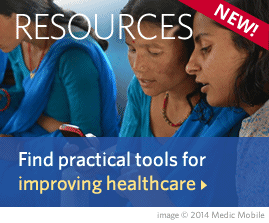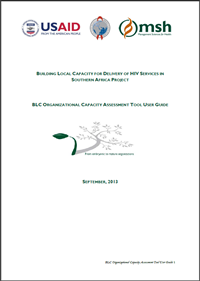
This tool can be utilized for the development of baseline and periodic capacity assessments of an organization, helping users to measure how an organization’s capacity changes over time. This process can help users to address the following operations research question: How does one measure the impact of organizational capacity building activities in regards to improved organizational performance and health service delivery outcomes?
Read More...
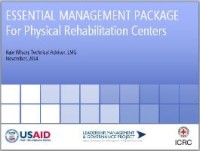
The Essential Management Package (EMP) is a toolkit of proven leadership development approaches that has been tailored for use by physical rehabilitation centers or other organizations providing services to persons with disabilities. It consists of the following components: (1) The Essential Management Systems Assessment Tool (EMSAT) and User Guide: a participatory assessment tool organizations can use to evaluate the state of development of their core management systems; (2) The Essential Management Systems Manual: a standardized model for procedures to strengthen management processes and systems; and (3) EMP Leadership Development Modules: a 10 module series of 4-hour leadership development and problem solving sessions that has been adapted from MSH’s proven Leadership Development Program Plus.
Read More...

Using the Standard Dashboard can help to enhance reporting processes and management for an overall improvement in organizational performance, reduce the volume of data information targeted at an overwhelmed manager, and promote timelier decision-making. The Dashboard Tools are used to assess whether enough organizational and IT capacity is present to support a Dashboard, and if so how to set up the first dashboard and organize the data collection and reporting process.
Read More...
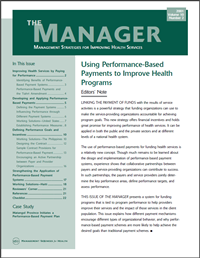
This issue of The Manager presents a system for funding programs that is tied to program performance to help providers improve their services and the impact of those services in the client population. This issue explains how different payment mechanisms encourage different types of organizational behavior, and why performance-based payment schemes are more likely to help achieve the desired goals than traditional payment schemes.
Read More...
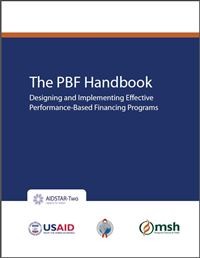
Performance-based Financing (PBF) is a powerful means of increasing the quality and quantity of health services by providing incentives to suppliers to improve performance and achieve results. PBF can increase the use and quality of health services, stabilize or decrease the costs of these services, help use limited resources effectively, and improve staff motivation and morale, a proven incentive for staff retention.
This PBF handbook has been designed for use by both program design officers at US Government (USG) agencies at the central and country levels as well as for PBF implementers at national and local levels. It is our hope that presenting this comprehensive overview of PBF from both the funders’ and the implementers’ perspectives will help to facilitate the design, implementation, and evaluation of PBF programs that enhance service delivery and create positive health outcomes.
Read More...

This issue of The Manager provides a comprehensive framework for addressing human capacity development. It presents steps for developing a strategy that will help managers sustain a supply of adequately trained health staff. It examines four components of planning and managing the workforce: polocy and financial requirements, human resource management, partnerships, and leadership. The issue also suggests actions managers and policymakers can take to address issues in these areas so that appropriately trained staff are available in the right place at the right time.
Read More...

This issue of The Manager discusses the role of local resources in strengthening health services. It will help health managers at the local level to identify types of local resources that may be available to them, decide on strategies for mobilizing these resources, and assess the value of such resources to their organization or program.
Read More...
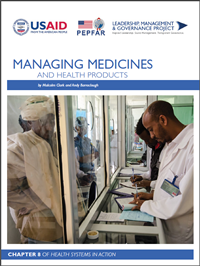
The publication outlines the essential elements of managing supplies at the district and subdistrict levels and in nongovernmental organizations (NGOs), provides practical guidance in assessing and improving the supply system at that level, and offers a range of other technical and managerial resources and references that will enable you to improve your management skills and study the areas that interest you further. Each section also provides overviews, guidelines, and checklists that will help you and your team identify and resolve major problems. (This publication is Chapter 8 of Health Systems in Action: An eHandbook for Leaders and Managers.)
Read More...
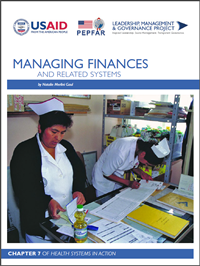
In this publication, we examine aspects of financial management and related office operations systems. Financial management is concerned with accounting and budgeting, along with the related reporting and analysis that allow managers, donors, and oversight bodies to know about revenue obtained or generated, assets owned, and expenses incurred, and to compare that information to previous years or desired results.
Read More...

The eHandbook emphasizes the central, critical element of every health system: people. It shows how to build leadership and management skills for yourself and your organization. It also covers management of the specific systems essential to an overall health system – governance, human resources, finances, supply chain management, health information and association monitoring and evaluation, and health service delivery. This tool can also be accessed as individual topical chapters.
Read More...













